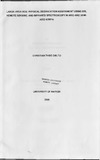Large-area soil physical degradation assessment using GIS, remote sensing and infrared spectroscopy in arid and semi-arid Kenya

View/
Date
2006Author
Omuto, Christine T
Type
ThesisLanguage
enMetadata
Show full item recordAbstract
Soil physical condition controls several important soil functions such as support
for biomass production, water cycling, filtering pollutants, and land surface
energy balance. However, physical degradation undermines this ability.
Currently, there is lack of rapid and repeatable methods that can facilitate timely
large-area assessment for effective monitoring and control of soil degradation.
This study tested the combined applications of point-measurements of physical
properties, soil diffuse spectral reflectance (DSR), and remote sensing to
spatially assess the degradation in a large watershed (4500 km2) in semi-arid
areas in eastern Kenya.
Indicators of the degradation were determined from 540 point-measurements of
infiltration and water retention and field observations of the visible signs of soil
physical degradation. The physical properties included steady-state infiltration
rates, sorptivity, water-holding capacity, pore distribution index, bulk density, and
air-entry potential. The parameters describing these properties were derived
using a nonlinear mixed effects (NLME) approach, which was also used to test
for the effects of other covariates such as land use and geographic features. A
screening protocol was then developed that took evidence of degradation from
visible assessments in the field, estimated soil physical properties, and rapid soil
tests based on soil DSR to predict the degradation cases. Over 90% sensitivity and specificity was achieved with a mixed effect logistic model based on a onethird
holdout sample. The screening results showed that soil DSR was a powerful
tool for detecting early warning indicators of degradation that were not readily
discernable from field observations.
In addition to the point-estimates of likelihood of physical degradation, timeintegrated
remote sensing indicators were also tested for power of spatial
prediction of the trends of the degradation in the study area. The standardized
deviations of land surface temperature (LST) and Normalized Difference
Vegetation Index (NDVI) from time-series Landsat scenes were used to study the
thermal and vegetation conditions of the degradation at sampled points. These
indices effectively predicted the likelihood of the degradation of the held-out
samples with 80% accuracy of ground reference data and were used to map the
degradation in the whole study area.
The approach developed in this study showed promising opportunity for spatial
prediction of physical degra~ation at high spatial resolution over large areas and
could be a useful tool for guiding policy decisions on sustainable land
management especially in the tropics where land use policies lack scientific
support.
Sponsorhip
University of NairobiPublisher
Department of Soil Science, University of Nairobi
Subject
Soil degradationGeographic Information Systems (GIS)
Infrared spectroscopy
Arid & semi-arid areas
